Updated scale_area has been deprecated; scale_size used instead. The gtable function gtable_filter() is used to extract the legends. And modified code used to replace default legend key in one of the legends.
If you are still looking for an answer to your question, here's one that seems to do most of what you want, although it's a bit of a hack in places. The symbol in the legend can be changes using kohske's comment here
The difficulty was trying to apply the two different size mappings. So, I've left the dot size mapping inside the aesthetic statement but removed the label size mapping from the aesthetic statement. This means that label size has to be set according to discrete values of a factor version of samplesize (fsamplesize). The resulting chart is nearly right, except the legend for label size (i.e., samplesize) is not drawn. To get round that problem, I drew a chart that contained a label size mapping according to the factor version of samplesize (but ignoring the dot size mapping) in order to extract its legend which can then be inserted back into the first chart.
## Your data
ib<- data.frame(
category = factor(c("Cat1","Cat2","Cat1", "Cat1", "Cat2","Cat1","Cat1", "Cat2","Cat2")),
city = c("CITY1","CITY1","CITY2","CITY3", "CITY3","CITY4","CITY5", "CITY6","CITY7"),
median = c(1.3560, 2.4830, 0.7230, 0.8100, 3.1480, 1.9640, 0.6185, 1.2205, 2.4000),
samplesize = c(851, 1794, 47, 189, 185, 9, 94, 16, 65)
)
## Load packages
library(ggplot2)
library(gridExtra)
library(gtable)
library(grid)
## Obtain the factor version of samplesize.
ib$fsamplesize = cut(ib$samplesize, breaks = c(0, 100, 1000, Inf))
## Obtain plot with dot size mapped to median, the label inside the dot set
## to samplesize, and the size of the label set to the discrete levels of the factor
## version of samplesize. Here, I've selected three sizes for the labels (3, 6 and 10)
## corresponding to samplesizes of 0-100, 100-1000, >1000. The sizes of the labels are
## set using three call to geom_text - one for each size.
p <- ggplot(data=ib, aes(x=city, y=category)) +
geom_point(aes(size = median, colour = category), alpha = .6) +
scale_size("Median", range=c(0, 15)) +
scale_colour_hue(guide = "none") + theme_bw()
p1 <- p +
geom_text(aes(label = ifelse(samplesize > 1000, samplesize, "")),
size = 10, color = "black", alpha = 0.6) +
geom_text(aes(label = ifelse(samplesize < 100, samplesize, "")),
size = 3, color = "black", alpha = 0.6) +
geom_text(aes(label = ifelse(samplesize > 100 & samplesize < 1000, samplesize, "")),
size = 6, color = "black", alpha = 0.6)
## Extracxt the legend from p1 using functions from the gridExtra package
g1 = ggplotGrob(p1)
leg1 = gtable_filter(g1, "guide-box")
## Keep p1 but dump its legend
p1 = p1 + theme(legend.position = "none")
## Get second legend - size of the label.
## Draw a dummy plot, using fsamplesize as a size aesthetic. Note that the label sizes are
## set to 3, 6, and 10, matching the sizes of the labels in p1.
dummy.plot = ggplot(data = ib, aes(x = city, y = category, label = samplesize)) +
geom_point(aes(size = fsamplesize), colour = NA) +
geom_text(show.legend = FALSE) + theme_bw() +
guides(size = guide_legend(override.aes = list(colour = "black", shape = utf8ToInt("N")))) +
scale_size_manual("Sample Size", values = c(3, 6, 10),
breaks = levels(ib$fsamplesize), labels = c("< 100", "100 - 1000", "> 1000"))
## Get the legend from dummy.plot using functions from the gridExtra package
g2 = ggplotGrob(dummy.plot)
leg2 = gtable_filter(g2, "guide-box")
## Arrange the three components (p1, leg1, leg2) using functions from the gridExtra package
## The two legends are arranged using the inner arrangeGrob function. The resulting
## chart is then arranged with p1 in the outer arrrangeGrob function.
ib.plot = arrangeGrob(p1, arrangeGrob(leg1, leg2, nrow = 2), ncol = 2,
widths = unit(c(9, 2), c("null", "null")))
## Draw the graph
grid.newpage()
grid.draw(ib.plot)



